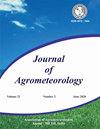耕作和残留物管理对半干旱气候条件下冬小麦温室气体排放和全球升温潜能值的影响
Q3 Agricultural and Biological Sciences
引用次数: 0
摘要
新德里印度农业研究所在 2020-21 年至 2021-22 年农业收获季节开展了一项为期两年的田间研究,目的是通过分小区设计,研究耕作和残留物管理对小麦产量、温室气体(GHGs)排放、全球升温潜能值(GWP)和碳效率比(CER)的影响。结果表明,耕作和残留物管理对小麦的谷物和生物量产量都有显著影响。与传统耕作(CT)相比,免耕(NT)使 CO2-C 排放量大幅减少了 19.9%,而 N2O-N 排放量则明显增加了 11.6%。然而,作物残茬覆盖的温室气体排放量显著增加,与去除残茬相比,这两年的排放量平均增加了 20.79%。与 CT 地块相比,NT 地块的 GWP 总体较低。在 2020-21 年期间,NTR+(3.07)和 2021-22 年期间,NTR0(3.12)的 CER 最高,原因是这两年的二氧化碳排放量较低,而 C 固定量较高。因此,可以建议在半干旱环境中种植小麦时采用免耕和残留物覆盖,与农民采用全面覆耕和清除残留物的做法相比,不仅可以降低温室气体排放量和全球升温潜能值,还能提供相当的产量和更高的核证减排量。本文章由计算机程序翻译,如有差异,请以英文原文为准。
Impact of tillage and residue management on greenhouse gases emissions and global warming potential of winter wheat in a semi-arid climate
A two-year field study was carried out at the Indian Agricultural Research Institute New Delhi, from rabi 2020-21 to 2021-22, with the aim of examining the impacts of tillage and residue management on yield, greenhouse gases (GHGs) emissions, global warming potential (GWP) and carbon efficiency ratio (CER) of wheat in a split plot design. The results indicated that both tillage and residue management significantly influenced the grain and biomass yield of wheat. In comparison to conventional tillage (CT), no-tillage (NT) resulted in a substantial reduction of CO2-C emissions by 19.9%, while it led to a notable increase of N2O-N emissions by 11.6%. However, there was a notable and significant rise in GHG emissions with crop residue mulching, registering on an average 20.79% higher emissions compared to residue removal for both the years. The GWP was overall lower in case of NT as compared to CT plots. The highest CER was observed in NTR+ (3.07) during 2020-21 and in NTR0 (3.12) during 2021-22 due to lower CO2 emissions and higher C fixation in both years. Therefore, it may be recommended that wheat can be cultivated in a semi-arid environment with no tillage and residue mulching to provide a comparable yield in addition to lower GHG emissions and GWP and higher CER compared to the farmers’ practice of CT and residue removal.
求助全文
通过发布文献求助,成功后即可免费获取论文全文。
去求助
来源期刊

Journal of Agrometeorology
农林科学-农艺学
CiteScore
1.40
自引率
0.00%
发文量
95
审稿时长
>12 weeks
期刊介绍:
The Journal of Agrometeorology (ISSN 0972-1665) , is a quarterly publication of Association of Agrometeorologists appearing in March, June, September and December. Since its beginning in 1999 till 2016, it was a half yearly publication appearing in June and December. In addition to regular issues, Association also brings out the special issues of the journal covering selected papers presented in seminar symposia organized by the Association.
 求助内容:
求助内容: 应助结果提醒方式:
应助结果提醒方式:


